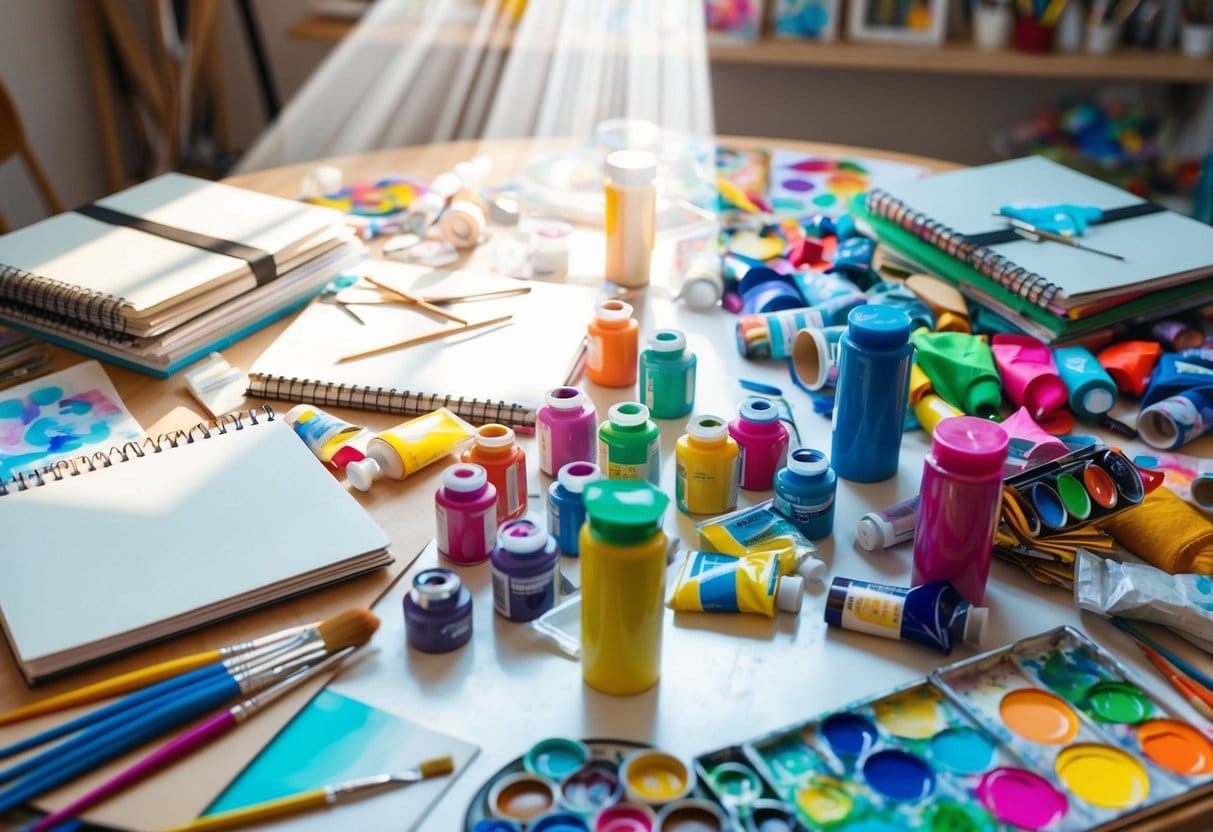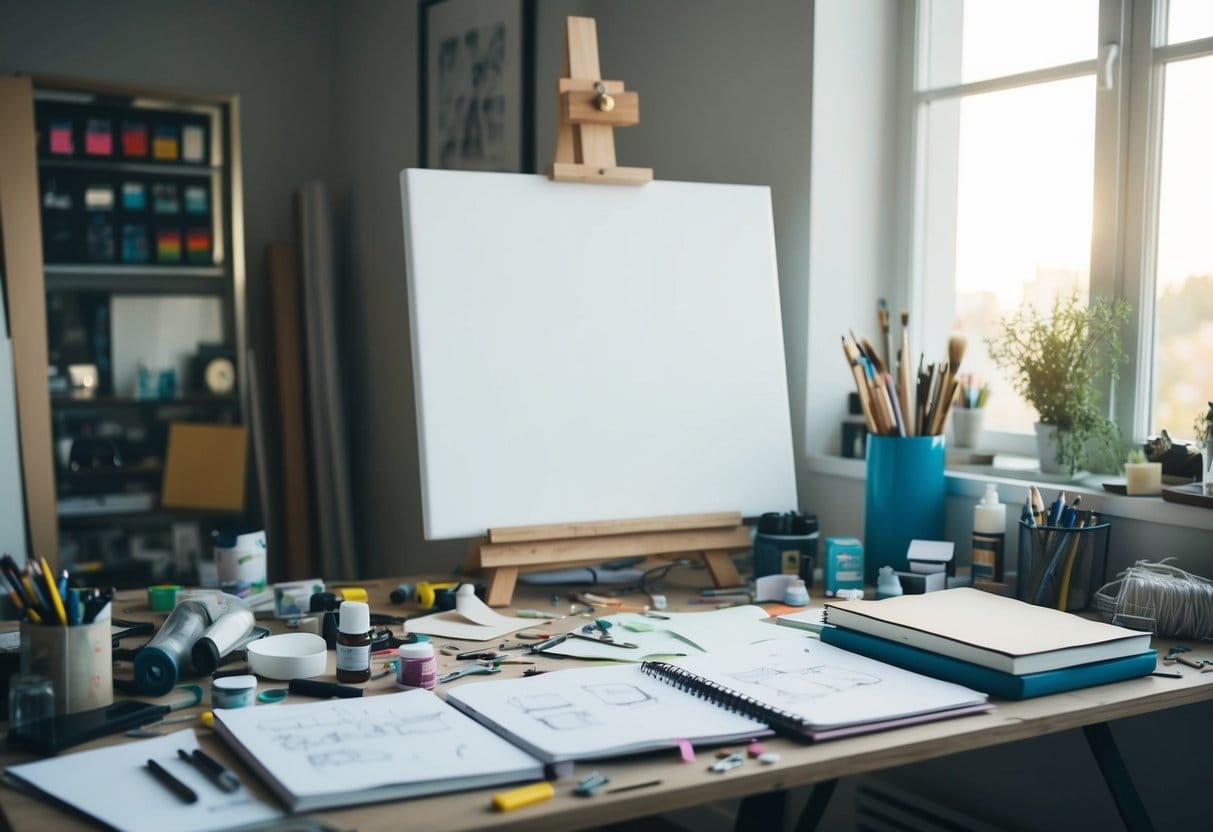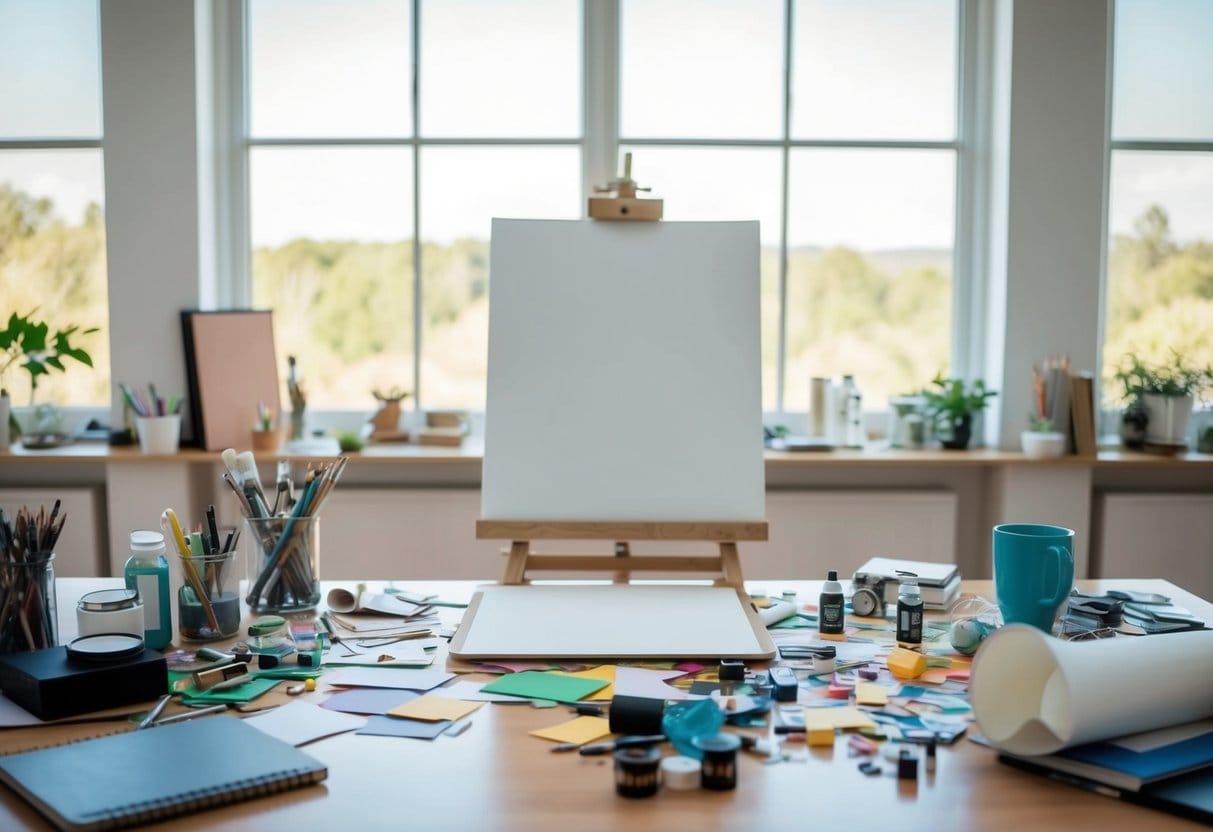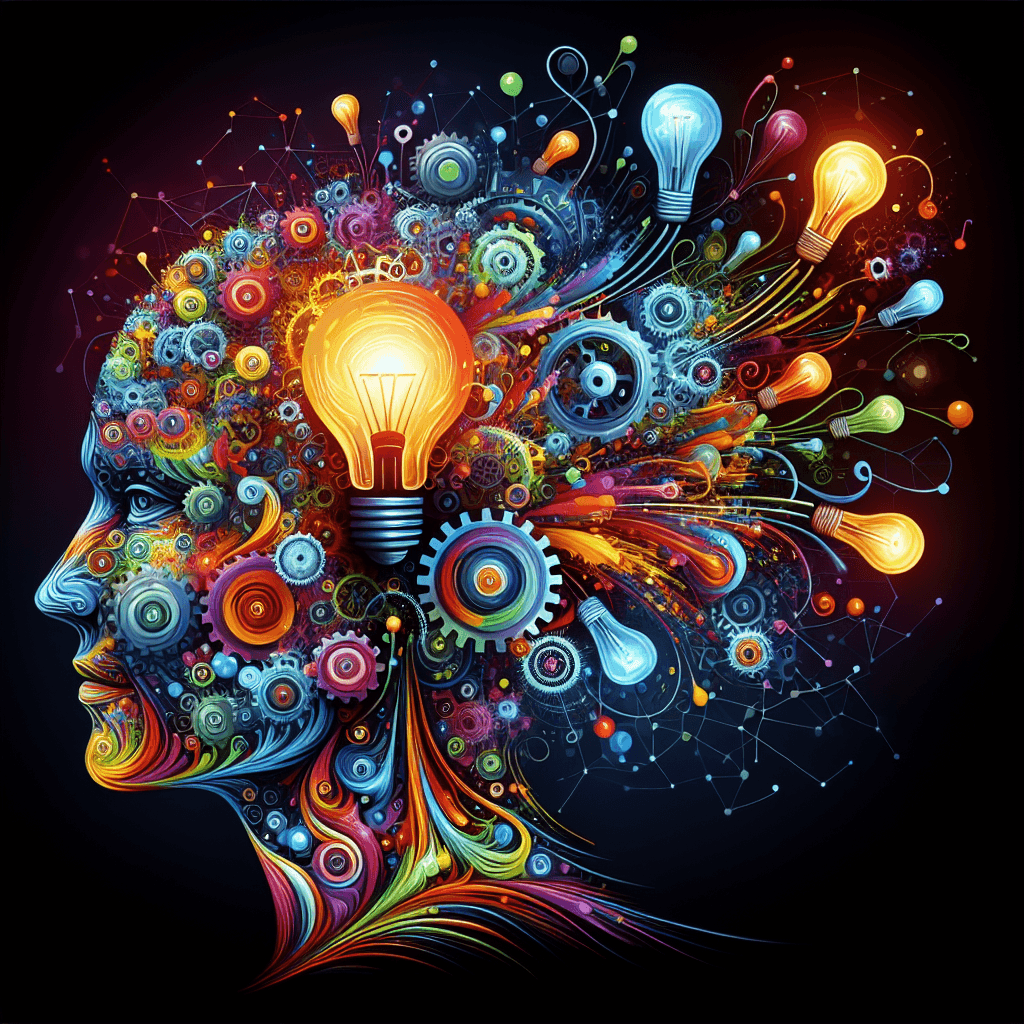Table of Contents
Creativity is not just a talent; it is a skill you can cultivate through deliberate practice. As innovation becomes increasingly vital for success, a broad range of practical exercises can help you unleash creativity.

Cultivating a creative mindset may seem daunting, but with the right strategies, you can achieve it.
Structured exercises, from drawing recognizable objects to engaging in interactive sessions, can improve how you approach problem-solving and innovation. These practices help foster an environment where creativity can flourish and be harnessed effectively across various domains.
Employing specific techniques designed to break mental barriers can lead to fresh, innovative ideas that drive progress both personally and professionally.
Key Takeaways
- Creative exercises enhance innovation skills.
- Collaboration fosters diverse creative ideas.
- Structured activities boost problem-solving abilities.
Laying the Foundations for Creative Thinking

Creative thinking is integral for innovation, demanding deliberate practice and an open mindset. Establish a strong base by understanding creativity’s nature and nurturing a mindset that encourages exploration and flexibility.
Understanding Creativity
Creativity often involves tapping into the right brain, which is associated with imagination and intuition. This part of the brain plays a significant role in innovation and problem-solving, allowing you to generate novel ideas.
It’s essential to recognize that creativity is not limited to artistic endeavors.
Creative activities can range from brainstorming sessions to simple day-to-day problem-solving. Embracing creativity requires openness to new experiences and willingness to challenge traditional thinking.
Developing creative thinking skills involves consistent effort and stepping outside comfort zones.
Fostering a Creative Mindset
A creative mindset thrives on curiosity, openness, and experimentation. Encouraging this mindset means questioning the status quo and seeking multiple perspectives.
One way to nurture creativity is through practices like divergent thinking, where you generate a wide range of ideas without immediate judgment.
To develop such a mindset, engage in activities that stimulate curiosity and allow for exploration. This can include brainstorming sessions, engagement in creative exercises, and maintaining a proactive approach to learning.
Cultivating this mindset is vital for fostering originality and innovation in your personal and professional life.
Practical Exercises to Stimulate Innovation and Unleash Creativity

Engaging in specific activities can significantly enhance your ability to generate new ideas and approach problems creatively. From daily routines to interactive sessions, these exercises offer practical methods to stimulate innovative thinking.
Daily Activities for a Creative Boost
Incorporating creative activities into your daily routine can ignite a constant stream of fresh ideas.
Begin your day by setting aside time for free drawing or doodling. This encourages your mind to explore visual thinking pathways.
Try the Thirty Circles Exercise: take a sheet with thirty blank circles and fill each one with recognizable objects like clocks or pizzas. This challenges you to think quickly and diversely.
Keep a journal. Daily reflections allow you to capture fleeting ideas, fostering a habit of creativity and innovation.
Meditation Techniques for Enhanced Creativity
Meditation can be a powerful tool in unlocking creative potential by fostering a relaxed state of mind.
Engage in mindfulness meditation, which focuses on breathing and present-moment awareness. This practice can improve your focus and reduce mental clutter, leading to clearer thinking.
Visual meditation involves closing your eyes and imagining different scenarios related to your current creative challenges. This not only enhances problem-solving skills but also fosters innovative thinking.
Try guided meditations that specifically target creativity to further enhance your imaginative capabilities.
Interactive Brainstorming Tactics
Interactive brainstorming sessions provide an engaging environment to generate numerous ideas quickly.
Start with group brainstorming, which leverages diverse perspectives to stimulate innovative solutions.
Implement the round-robin technique where each participant adds to ideas progressively. This ensures everyone’s thoughts are considered, building upon existing suggestions.
Consider using brainwriting, where ideas are anonymously written by participants and shared. This method can reduce inhibition and encourage more radical, creative proposals.
Providing a variety of interaction formats helps cater to different thinking styles, maximizing the potential for innovative outcomes.
Virtual Collaboration and Creativity

Embracing virtual platforms can enhance creativity through innovative use of digital tools and structured brainstorming sessions. With a focus on collaboration, remote teams can creatively solve problems and generate new ideas.
Utilizing Virtual Resources
To unlock creativity, leverage the various virtual resources available.
Digital platforms like online whiteboards, collaborative documents, and project management tools provide spaces for ideas to flourish.
Utilizing these resources allows team members to contribute in real-time, fostering an inclusive environment.
Key Tools:
- Online Whiteboards: Share and structure ideas visually.
- Collaborative Documents: Multiple users edit simultaneously.
- Project Management Software: Organize tasks and track progress.
These tools help maintain seamless communication, enabling creatives to work efficiently from diverse locations. By integrating them into daily workflows, you cultivate a culture of innovation that transcends physical boundaries.
Remote Brainstorming Sessions
Organize remote brainstorming sessions to spur creativity among team members.
Video conferencing platforms provide the opportunity to gather participants, regardless of their physical locations.
Establish clear objectives for each session and guide discussions to maintain focus and productivity.
Steps for Effective Sessions:
- Define Goals: Clarify the purpose of the brainstorming session.
- Use Facilitation Techniques: Encourage participation through structured activities.
- Capture Ideas: Utilize the virtual tools to document insights.
By fostering open communication, promoting diverse perspectives, and capturing ideas effectively, these sessions can yield innovative solutions. Having a facilitator can ensure each session remains on track, allowing creativity to thrive in a collaborative setting.
Building Creative Teams

Developing creative teams requires a focus on leadership dynamics and communication skills. Effective leadership sets the foundation for innovation, while robust communication ensures diverse perspectives thrive within a collaborative environment.
Leadership in Creative Environments
Leadership plays a crucial role in fostering creativity within teams.
As a leader, your primary task is to create a safe space where team members feel comfortable sharing new ideas without fear of criticism.
Encouraging risk-taking and providing support when mistakes occur is essential.
Embrace a coaching approach by offering guidance that empowers others rather than dictating their actions.
Regularly engage in activities like brainstorming sessions to stimulate creative thinking. Make it a point to recognize and reward innovative contributions, which can significantly boost morale and motivation.
Empower your team by involving them in decision-making processes to cultivate ownership and accountability.
Balancing direction with the freedom to explore nurtures a dynamic and inventive team culture.
Communication for Diverse Perspectives
Communication is pivotal in harnessing diverse perspectives within a team.
Encourage an inclusive culture by inviting contributions from all members regardless of their role or level of experience. This fosters a sense of belonging and enriches the team’s collective intelligence.
Utilize tools such as organized feedback sessions and open forums to ensure everyone’s voice is heard.
Developing active listening skills is essential, as it demonstrates respect and openness towards various viewpoints.
Implement visual aids like mind maps to help consolidate diverse ideas and simplify complex concepts.
Promoting transparency and facilitating information exchange encourages collaboration and sparks creativity. By valuing different perspectives, you not only enhance problem-solving but also drive innovative outcomes.
The Role of Education in Creative Development

Education plays a crucial role in shaping creative abilities, providing foundational tools and experiences that nurture innovation and imagination. By integrating creative thinking into educational practices, you can enhance problem-solving skills and encourage new ideas.
The Importance of Reading
Reading stimulates the mind and fosters creativity by exposing you to diverse perspectives and ideas. Through literature and various texts, you encounter narratives that push the boundaries of imagination.
This exposure nurtures the ability to think outside the box. Practicing active reading and engaging in discussions about different interpretations can further enhance your creative thinking skills.
Books, articles, and essays offer a wide range of viewpoints that expand your thinking. Incorporating reading into your routine encourages the development of flexibility in thought and the ability to generate innovative solutions to complex problems.
Promoting Continuous Learning
Continuous learning is key to sustained creative development.
By engaging in lifelong learning, you keep your mind agile and receptive to new concepts and skills.
Educational systems that emphasize ongoing learning encourage you to seek knowledge beyond the classroom.
Workshops, courses, and experiential learning opportunities offer avenues to explore new areas of interest and fuel creative thinking.
Participation in diverse learning experiences helps you refine your abilities and apply creative skills in various aspects of your life. Active participation in learning communities enables you to share ideas and gain insights that inspire innovation.
Executing and Implementing New Ideas
Executing new ideas requires a clear strategy and structured approach to transform creative concepts into actionable innovations. It’s essential to validate innovations through verification and testing to ensure their effectiveness and alignment with goals.
From Concept to Reality
Moving from concept to reality involves detailed planning and execution.
Begin by outlining the critical steps required to implement your innovation. Identify resources, responsibilities, and timelines to guide the process effectively.
You must focus on breaking down tasks into manageable parts, allowing you to track progress efficiently.
Create a feedback loop with stakeholders to refine and adjust your plan as necessary.
This will involve regular check-ins and updates to ensure that the project remains on track. Use tools like project management software to stay organized and communicate clearly with your team to seamlessly transition from idea to execution.
Verification and Testing of Innovations
Verification and testing are crucial to assess the feasibility and effectiveness of your innovation.
Start by defining key metrics and performance indicators that will help measure success.
Conduct trials or pilot programs to gather data and insights on your innovation’s impact and functionality.
Engage in feedback sessions with real users to understand their experiences and identify any improvements needed.
This iterative process allows for refinement and helps mitigate risks before full-scale implementation. Documentation of findings and a thorough analysis will guide the final adjustments needed to optimize your innovation for successful deployment.
About Us: Fostering Innovation Together
You are invited to join us in our commitment to fostering innovation and creativity. We focus on creating an environment where ideas thrive and new concepts come to life.
Our team brings together diverse talents and skills dedicated to exploring new frontiers. With your unique insights, we aim to nurture an atmosphere of collaboration and openness.
What We Offer:
- Workshops: Engaging activities that inspire creativity and teamwork.
- Resources: Access to tools and techniques supporting innovative thinking.
- Guidance: Expert advice and mentoring to help you grow and innovate.
Values We Embrace:
- Inclusivity
- Curiosity
- Resilience
Your role is crucial in shaping a culture where innovation flourishes. We encourage you to actively participate and share your thoughts.
Together, we can build a future filled with groundbreaking ideas and opportunities. Join us on this exciting journey towards endless possibilities.
Frequently Asked Questions
Creativity and innovation can be harnessed through various exercises and activities.
Short exercises like quick drawing challenges can spark creativity.
Adults can engage in group brainstorming to improve their skills.
Teachers play a vital role in stimulating students’ creativity with interactive techniques, while artists can enhance their work through targeted practices.
What are some effective creativity exercises that can be completed within 5 minutes?
Try drawing exercises such as the 30-second sketch. This activity involves drawing an object from memory in 30 seconds, prompting your brain to think quickly and creatively.
Another option is mind mapping, where you jot down words related to a central concept to make connections and explore new ideas swiftly.
What activities can adults do to improve their creative thinking skills?
Participate in group brainstorming sessions to encourage the free flow of ideas.
Engage in exercises like role-playing, where you imagine solving a problem as someone else.
Take part in creative writing prompts to challenge your mind and boost creative thinking. These activities help adults break out of their usual thought patterns.
How can teachers stimulate creativity in students through interactive activities?
Teachers can use improvisational games that require students to think quickly and adapt.
Collaborative projects encourage creative thinking and teamwork.
Incorporating art projects into lessons allows students to express and explore ideas visually and conceptually, fostering a creative classroom environment.
Gamifying learning can also help stimulate creativity.
What are some innovation exercises that can help in generating new ideas?
Engage in rapid prototyping where you create quick and simple versions of your ideas using available materials.
Conduct “what if” sessions to explore hypothetical scenarios that push the boundaries of current knowledge.
Both methods allow for exploration and iteration, which are essential for innovation.
Another exercise is problem-reversal thinking, where you flip a challenge on its head.
In what ways can artists enhance their creativity through specialized exercises?
Artists might experiment with blind contour drawing, focusing on the subject without looking at the paper. This technique fosters intuition and observation skills.
Engaging in the practice of using unfamiliar materials can also push artists to discover new methods and styles, promoting innovation in their work.
Can you describe how to perform Ideo’s 30 circles activity to boost creative output?
To perform this activity, take a sheet with 30 empty circles on it, and set a timer for 3 minutes. Fill in each circle with a unique drawing or object.
The goal is to avoid repetition and stretch your imagination. This exercise pushes creative boundaries and encourages quick thinking, making it great for team settings or individual practice.
Ready to unleash your creativity and boost innovation?
Explore these resources:
- “Creativity, Inc.: Overcoming the Unseen Forces That Stand in the Way of True Inspiration” by Ed Catmull (Co-founder of Pixar): Insights into fostering a creative culture.
- “Lateral Thinking: Creativity Step by Step” by Edward de Bono: Introduces powerful techniques for thinking outside conventional patterns.
- “A Whack on the Side of the Head: How You Can Be More Creative” by Roger von Oech: Offers exercises and insights to challenge assumptions and spark new ideas.
- “Steal Like an Artist: 10 Things Nobody Told You About Being Creative” by Austin Kleon: Encourages embracing influence and remixing ideas.
- “The Artist’s Way: A Spiritual Path to Higher Creativity” by Julia Cameron: A classic guide with practical exercises like “Morning Pages” and “Artist Dates.”
- “Design Thinking: A Guide to Creative Problem Solving for Everyone” by Michael G. Luchs, Scott Swan, and Abbie Griffin: Introduces a structured approach to innovation.




